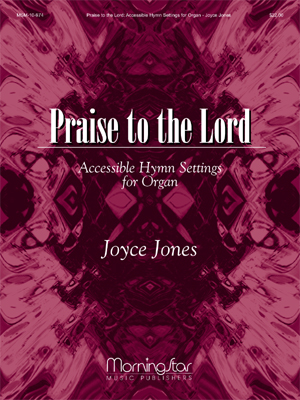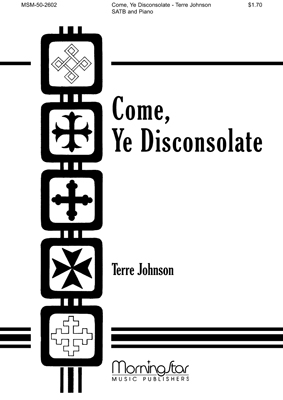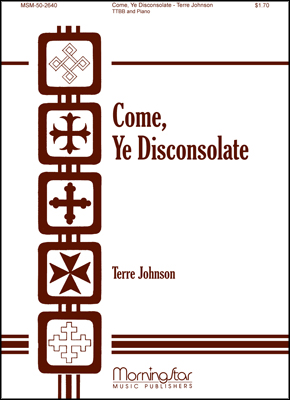- |
User Links
Come, Ye Disconsolate

Come, ye disconsolate, where'er ye languish
Author and Reviser (st. 1-2): Thomas Moore (1816); Author (st. 3): Thomas Hastings (1832)Tune: CONSOLATOR (Webbe)
Confession Songs
Published in 1079 hymnals
Printable scores: PDF, MusicXMLPlayable presentation: Lyrics only, lyrics + musicAudio files: MIDI, Recording
Representative Text
1 Come, you disconsolate, where'er you languish;
come to the mercy seat, fervently kneel.
Here bring your wounded hearts, here tell your anguish;
earth has no sorrows that heaven cannot heal.
2 Joy of the desolate, light of the straying,
hope of the penitent, fadeless and pure!
Here speaks the Comforter, in mercy saying,
"Earth has no sorrows that heaven cannot cure."
3 Here see the bread of life; see waters flowing
forth from the throne of God, pure from above.
Come to the feast prepared; come, ever knowing
earth has no sorrows but heaven can remove.
Psalter Hymnal, 1987
Author and Reviser (st. 1-2): Thomas Moore
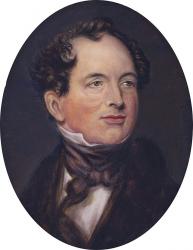 Thomas Moore United Kingdom 1779-1852. Born at Dublin, Ireland, the son of a grocer, he showed an early interest in music and acting. He was educated at a private school and Trinity College, Dublin. He read at the Middle Temple for the Bar. Moore did not profess religious piety. His translations of ‘Anacreon’ (celebrating wine, women, and song) were published in 1800, with a dedication to the Prince of Wales. He also wrote a comic opera, “the gypsy prince”, staged that year. In 1801 he published a collection of his own verse, “Poetical works of the late Thomas Little Esq”. A Catholic patriot, he defended the Church of Ireland, especially in later politics. In 1803 he held a post under the Government in Bermuda as regis… Go to person page >
Thomas Moore United Kingdom 1779-1852. Born at Dublin, Ireland, the son of a grocer, he showed an early interest in music and acting. He was educated at a private school and Trinity College, Dublin. He read at the Middle Temple for the Bar. Moore did not profess religious piety. His translations of ‘Anacreon’ (celebrating wine, women, and song) were published in 1800, with a dedication to the Prince of Wales. He also wrote a comic opera, “the gypsy prince”, staged that year. In 1801 he published a collection of his own verse, “Poetical works of the late Thomas Little Esq”. A Catholic patriot, he defended the Church of Ireland, especially in later politics. In 1803 he held a post under the Government in Bermuda as regis… Go to person page >Author (st. 3): Thomas Hastings
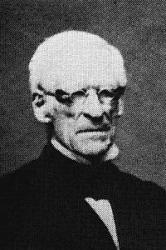 Hastings, Thomas, MUS. DOC., son of Dr. Seth Hastings, was born at Washington, Lichfield County, Connecticut, October 15, 1784. In 1786, his father moved to Clinton, Oneida Co., N. Y. There, amid rough frontier life, his opportunities for education were small; but at an early age he developed a taste for music, and began teaching it in 1806. Seeking a wider field, he went, in 1817, to Troy, then to Albany, and in 1823 to Utica, where he conducted a religious journal, in which he advocated his special views on church music. In 1832 he was called to New York to assume the charge of several Church Choirs, and there his last forty years were spent in great and increasing usefulness and repute. He died at New York, May 15, 1872. His aim was the… Go to person page >
Hastings, Thomas, MUS. DOC., son of Dr. Seth Hastings, was born at Washington, Lichfield County, Connecticut, October 15, 1784. In 1786, his father moved to Clinton, Oneida Co., N. Y. There, amid rough frontier life, his opportunities for education were small; but at an early age he developed a taste for music, and began teaching it in 1806. Seeking a wider field, he went, in 1817, to Troy, then to Albany, and in 1823 to Utica, where he conducted a religious journal, in which he advocated his special views on church music. In 1832 he was called to New York to assume the charge of several Church Choirs, and there his last forty years were spent in great and increasing usefulness and repute. He died at New York, May 15, 1872. His aim was the… Go to person page >Text Information
| First Line: | Come, ye disconsolate, where'er ye languish |
| Title: | Come, Ye Disconsolate |
| Author and Reviser (st. 1-2): | Thomas Moore (1816) |
| Author (st. 3): | Thomas Hastings (1832) |
| Meter: | 11.10.11.10 |
| Language: | English |
| Copyright: | Public Domain |
| Liturgical Use: | Confession Songs |
English
- 52 Hymns of the Heart: with an appendix of favorite solos and choruses (Missionary and Church Extension Ed.) #52
- A Book of Hymns for Public and Private Devotion (15th ed.) #162
- A Book of Hymns for Public and Private Devotion. (10th ed.) #162
- A Choice Selection of Hymns and Spiritual Songs for the use of the Baptist Church and all lovers of song #466
- A Chord #d16
- A Collection of Choral Hymns for the ... Hanson Place Methodist Episcopal Congregation #d30
- A Collection of Hymns and a Liturgy: for the use of Evangelical Lutheran Churches, to which are added prayers for families and individuals (New and Enl. Stereotype Ed.) #640
- A Collection of Hymns for Public, Social and Domestic Worship #d154
- A Collection of Hymns for Public, Social, and Domestic Worship #352
- A Collection of Hymns for Public, Social, and Domestic Worship #d153 10 shown out of 666
Latin
Spanish
Yiddish
Notes
Scripture References:
st. 1 = Heb. 4:14-16
st. 2 = Isa. 54:7, John 14:18
Like the previous four hymns, "Come, You Disconsolate" is an invitation, a call for sinners to come to Christ with their sorrows and find healing (st. 1), experience hope and comfort (st. 2), and participate in the feast of the Lamb (st. 3). The text empha¬sizes the consolation that Christ offers to those who turn to him in faith.
Entitled "Relief in Prayer," this text by Thomas Moore (b. Dublin, Ireland, 1779; d. Devizes, Wiltshire, England, 1852) was first published in three stanzas in Moore's Sacred Songs, Duets and Trios (1816), one of his thirty-two hymn texts in that collection. Minor changes were made for the 1824 edition.
Although born and educated in Ireland, Moore spent much of his adult life in England. In 1804 he began a civil service appointment in Bermuda but delegated it to a deputy, who embezzled money that Moore had to pay back! He traveled throughout the eastern United States and Canada in 1840 but then returned to London. Moore became known for two achievements–playing and singing Irish folk songs in aristocratic homes and writing poetry. His publications include a biography of Lord Byron and A Selection of Irish Melodies (1807-1834).
The American composer Thomas Hastings (b. Washington, Litchfield County, CT, 1784; d. New York, NY, 1872) revised Moore's stanzas 1 and 2 and substituted his own third stanza when he published the hymn in Spiritual Songs for Social Worship (1831), compiled by Hastings and Lowell Mason (PHH 96). Like Lowell Mason, Hastings was a rire1ess writer, composer, and promoter of church music in the European style (he thought the shape-note tradition "unscientific"). He wrote some six hundred hymn texts and composed about a thousand tunes, most of which have been forgotten. From 1823 to 1832 he lived in Utica, New York, where he directed the Oneida County Choir and was editor of a religious magazine, The Western Recorder. In 1832 Hastings was invited by twelve churches to come to New York City to improve their psalm singing. He stayed there the rest of his life, composing, writing, teaching, and directing. He published some fifty volumes, including his Utica Collection (1816, later expanded as Musica Sacra), Spiritual Songs for Social Worship (with Mason, 1833), and Church Melodies (1858).
Liturgical Use:
As an invitation hymn in evangelistic services, possibly with altar calls or with the Lord's Supper (note st. 3); useful in the service of confession/forgiveness and comfort/encouragement.
--Psalter Hymnal Handbook, 1987
Access an additional article on the Canterbury Dictionary of Hymnology:
Tune
CONSOLATOR (Webbe)CONSOLATION was originally set for solo voice to "Alma redemptoris mater" by Samuel Webbe, Sr. (PHH 112), in his Collection of Motetts and Antiphons (1792). Thomas Hastings adapted the tune for use with Moore's text in Spiritual Songs for Social Worship (1831). CONSOLATION is also known as ALMA and…
For Leaders
Text:
The original text was written by Thomas Moore for his own collection Sacred Songs in 1816. He revised his poem in 1824. Thomas Hastings took Moore's poem and edited it, replacing the third stanza with one of his own. This text was published in Spiritual Songs for Social Worship in 1831 by Hastings and Lowell Mason, and has become the standard text for this hymn.
Moore's original third stanza began “Come, ask the infidel what boon he brings us,” which challenged unbelievers to find a remedy for sorrow equal to God's comfort. This also gives some insight on what Moore meant by “you disconsolate” in the first stanza – believers only, with their troubles and sadness. With Hastings's third stanza replacing Moore's, it is now easier to read the first stanza as appealing both to believers in need of comfort and to unbelievers who have never felt God’s peace.
The three stanzas of this poem all have a similar final line comparing the sorrows of earth to the power of God in heaven. The first stanza is a call to all of humanity who are downtrodden and sorrowful, while the second describes the comforting God to whom the disconsolate come with their troubles. The final stanza depicts heaven.
Tune:
Moore wrote his text for a tune by Samuel Webbe, Sr., which may have been arranged from a folk tune, perhaps with German origins. Webbe had published the tune as a vocal solo with the text “Alma redemptoris mater” in his Collection of Motetts and Antiphons in 1792. Hastings and Mason adapted the tune for publication with this text in Spiritual Songs for Social Worship in 1831. A footnote in that publication reads, “Arranged as a Solo and Duet. This arrangement is intended for families, and for small praying circles ….” The principal name of the tune is CONSOLATION, but this is sometimes confused with another tune by the same name (which is also called MORNING SONG). A similar alternate title is CONSOLATOR. Occasionally the tune is called ALMA, after the text with which Webbe paired it. This tune may be sung in unison, as it was originally intended.
When/Why/How:
This hymn is best suited to services of confession or of comfort and encouragement. Terre Johnson wrote a moving setting of “Come, Ye Disconsolate” for choir with piano accompaniment in memory of the victims of a 2007 tornado in Alabama. Much of the setting is sung in unison or two-part harmony, with the full choir on the final stanza. This setting was also published for vocal solo in “Three Hymns of Hope.”
Tiffany Shomsky, Hymnary.org
Timeline
Arrangements
Media
Psalter Hymnal (Gray) #538
- MIDI file from Baptist Hymnal 1991 #67
- MIDI file from Baptist Hymnal 1991 #67
- MIDI file from The Cyber Hymnal #1140
- Audio recording from Evangelical Lutheran Worship #607
- Audio recording from Lift Up Your Hearts: psalms, hymns, and spiritual songs #614
- Audio recording from Lift Up Your Hearts: psalms, hymns, and spiritual songs #614
- Audio recording from Psalter Hymnal (Gray) #538
- MIDI file from Psalter Hymnal (Gray) #538
- MIDI file from Psalter Hymnal (Gray) #538
- MIDI file from Timeless Truths #424
- MIDI file from The United Methodist Hymnal #510
- Audio recording from The United Methodist Hymnal #510


 My Starred Hymns
My Starred Hymns